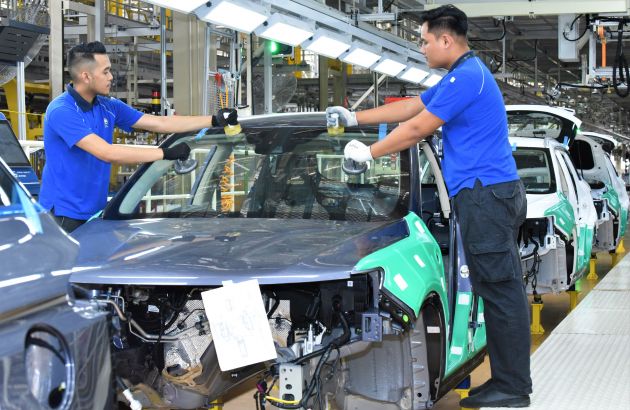It’s no secret that Malaysia has dragged its feet in stimulating the public’s adoption of electric vehicles, and this was highlighted in a damning analysis report by Maybank Investment Bank Research. The article showed just how far the country has fallen behind its Southeast Asian peers, despite having initially led the race for green vehicles in the early 2010s.
The bank’s research arm said that Malaysia’s roadmap for the future of its automotive industry, the National Automotive Policy (NAP) 2020, lacks definition. Delayed for several months, the plan debuted in the final days of the previous Pakatan Harapan administration; notably, it did not provide specifics regarding any incentives for industry players, nor any concrete details on the then-nascent New National Car Project (NNCP), which has now gone silent.
Instead, the NAP painted broad strokes with its five key objectives. These included the development of a Next Generation Vehicle (NxGV) technology ecosystem, the expansion of the Mobility-as-a-Service (MaaS) sector, supporting the domestic automotive industry to cope with the fourth industrial revolution, ensuring that the overall ecosystem benefitted from the NxGV ecosystem, and reducing carbon emissions.
The ten-year plan also included seven roadmaps and blueprints, plus 17 targets; the Electric Mobility Blueprint is also aimed at getting 125,000 charging stations up and ready by 2030. However, Malaysia lacks the clear milestones outlined by leading ASEAN countries, including Thailand, Indonesia and Singapore. The Land of Smiles, for instance, set a goal back in 2015 of building 1.2 million electric vehicles by 2026.
As part of this commitment, the Thai government laid out a three-phase plan set to last until 2036, covering the areas of industry incentives, standards, infrastructure and charging prices, among others. The country wants to be the region’s EV hub by 2025 and has already rolled out tax breaks for carmakers and battery manufacturers to support its ambitions.
Meanwhile, Indonesia is looking for electrified vehicles to make up at least 20% of its overall production by 2025, including 2,200 EVs, 711,000 hybrids and 2.1 million electric motorcycles. As for Singapore, the island nation announced in its Budget 2020 that it intends to phase out petrol- and diesel-powered vehicles by 2040, and has introduced several incentives for EV buyers and committed to building more charging stations.
The gulf between Malaysia’s approach and those of other leading ASEAN countries has led to starkly different outcomes. Vehicle production on our shores is still largely centred on cars powered by internal combustion engines, with Porsche being the latest surprising party reportedly eyeing local production. The Maybank report mentions the Macan and Cayenne SUVs as being the candidates for CKD operations.


But Malaysia has also lost a significant foreign player in Hyundai, which is moving its regional headquarters from Mutiara Damansara to Indonesia as part of setting up a US$1.55 billion (RM6.27 billion) plant in Bekasi. And while Hyundai-Sime Darby Motors (part of Sime Darby Motors, a key player named in the Porsche rumours) has committed to assembling more models in the near future, the decision must still hurt.
Hyundai, by the way, isn’t the only carmaker investing in Indonesia, which has also courted companies like Toyota and battery maker CATL – the latter, a supplier to Tesla, is building a US$5.1 billion (RM20.6 billion) plant and is expected to begin production there by 2024. Speaking of Tesla, the government is considering an investment proposal from the leading EV maker, while LG Chem is also looking to invest in a battery plant.
Singapore isn’t known for building cars (at least, not after the high-profile Dyson project was cancelled), but even Hyundai is building a small-scale EV production facility there, with a planned capacity of 30,000 units per annum by 2025. Even Vietnam is surging ahead, with homegrown carmaker VinFast revealing three new electric SUVs it plans to build this year.
But most players are choosing to invest in Thailand. Between 2018 and 2019, the country’s Board of Investment (BOI) approved 26 applications worth a total of US$2.6 billion (RM10.5 billion), including BMW, Mercedes-Benz and the three biggest Japanese carmakers (Toyota, Honda and Nissan). Late last year, the BOI announced the approval of several additional companies, including Mitsubishi and SAIC.
By contrast, Malaysia seems to be in a holding pattern, and a number of carmakers who have invested in the country are bemoaning the lack of progress. Just this week, Mercedes-Benz Malaysia said that it remained committed to its EV strategy but needed a more defined industry roadmap for it to do so.
Over to you now. Do you believe Malaysia should bolster its EV roadmap, and what incentives would make you purchase an EV? Sound off in the comments after the jump.
The post Malaysia lags behind ASEAN on EV incentives – report appeared first on Paul Tan's Automotive News.




0 Comments